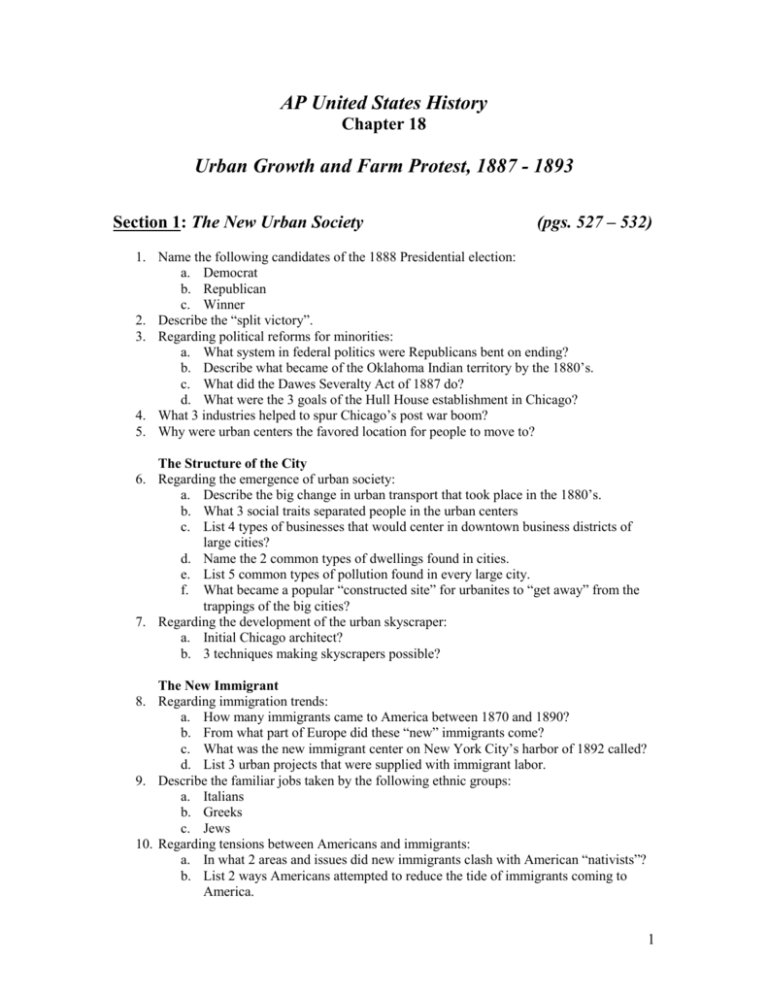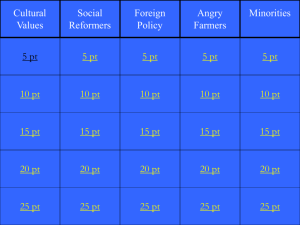AP United States History
advertisement

AP United States History Chapter 18 Urban Growth and Farm Protest, 1887 - 1893 Section 1: The New Urban Society (pgs. 527 – 532) 1. Name the following candidates of the 1888 Presidential election: a. Democrat b. Republican c. Winner 2. Describe the “split victory”. 3. Regarding political reforms for minorities: a. What system in federal politics were Republicans bent on ending? b. Describe what became of the Oklahoma Indian territory by the 1880’s. c. What did the Dawes Severalty Act of 1887 do? d. What were the 3 goals of the Hull House establishment in Chicago? 4. What 3 industries helped to spur Chicago’s post war boom? 5. Why were urban centers the favored location for people to move to? The Structure of the City 6. Regarding the emergence of urban society: a. Describe the big change in urban transport that took place in the 1880’s. b. What 3 social traits separated people in the urban centers c. List 4 types of businesses that would center in downtown business districts of large cities? d. Name the 2 common types of dwellings found in cities. e. List 5 common types of pollution found in every large city. f. What became a popular “constructed site” for urbanites to “get away” from the trappings of the big cities? 7. Regarding the development of the urban skyscraper: a. Initial Chicago architect? b. 3 techniques making skyscrapers possible? The New Immigrant 8. Regarding immigration trends: a. How many immigrants came to America between 1870 and 1890? b. From what part of Europe did these “new” immigrants come? c. What was the new immigrant center on New York City’s harbor of 1892 called? d. List 3 urban projects that were supplied with immigrant labor. 9. Describe the familiar jobs taken by the following ethnic groups: a. Italians b. Greeks c. Jews 10. Regarding tensions between Americans and immigrants: a. In what 2 areas and issues did new immigrants clash with American “nativists”? b. List 2 ways Americans attempted to reduce the tide of immigrants coming to America. 1 Urban Political Machine 11. Regarding the “political machines” of city politics: a. How could ward leaders be insured votes on Election Day? b. List 2 popular “political bosses” of Ney York City and Boston 12. Regarding “political bosses”: a. What boss completely “owned” New York City in the late 1860’s? b. As cities grew larger, how did “bosses” often gain political influence in their districts? c. In what ways were the bosses actually smart politicians? d. Which groups in America benefitted the most from the political bosses e. How did “nativists” reformers see political machines? 13. How did settlement houses often approach the new immigrant? Section 18-2: The Diminishing Rights of Minority Group (pgs. 532 – 535) 14. List 4 groups of Americans who suffered blatant discrimination due to their ethnicity during the 1880’s. 15. Regarding Native Americans: a. List 2 promises offered by the Ghost Dance religion b. Who was the Ghost Dance prophet? c. How did whites view the Ghost Dance religion? d. Where was the last Indian resistance against US Army? 16. Regarding Mexican-Americans: a. Describe the conflict between Anglo ranchers and Hispanic residents of the newly acquired southwestern region b. What was the Las Gorra Blancas 17. Regarding Chinese- Americans: a. List the 2 immediate jobs taken by Chinese in the 1840’s and 1850’s. b. What was the white reaction to Chinese competition for employment c. Describe the Chinese Exclusion Act of 1882 d. Compare the Chinese population for 1882 and 1892 e. What was the function of the Chinese “Six Companies”? The Spread of Segregation 18. Regarding Black Americans: a. List the 2 leading national attitudes that allowed the South to increase segregation against Blacks in the South? b. How did Northerners view white actions in the South? c. List 5 common areas of racial discrimination in Southern society d. Judicial penalties for crimes committed? e. Voting opportunities by 1880’s? 19. Describe the following voting restrictions placed on Blacks in the South: a. Literacy Test b. Poll Tax 20. If Blacks did vote, what risks did they incur for doing so? 21. List the following statistics regarding violence on Blacks for voting: a. Annual amount lynched b. Prison deaths 22. What was the US Supreme Court’s ruling in Plessey v. Ferguson? 2 A Victorian Society 23. Regarding the Victorian Age: a. When was the period of Queen Victoria’s reign? b. List the 4 standards of acceptable social behavior during the “Victorian Age” c. Describe the general rules of dating d. What was the central function of marriage e. The expected influence of women over men within a marriage f. The role of corporal punishment in child rearing g. List the 4 leading religions practiced in 1890’s America 24. Regarding the emergence of popular sports culture: a. What 2 leading sports emerged across the United States by the 1890’s? b. What Irish figure dominated the boxing worlds in the 1880’s? c. What popular sporting craze swept the United States in the 1890’s Section 18-3: Voices of Protest and Reform (pgs. 535 – 537) 25. Describe the 3 components of Nationalism as offered in Bellamy’s 1888 Looking Backward: 2000 – 1887. 26. Regarding the industrialization of American society: a. Describe Social Darwinism b. Describe Walter Rauschenbusch’s Social Gospel c. Describe the argument put forth by Washington Gladden in his book Applied Christianity d. What was the WCTU? e. What aspect to temperance did the WCTU add to its focus 27. Regarding the social role of women: a. What function did the women’s social clubs of the 1890’s perform? 28. List the goal of the following women’s clubs: a. General Federation of Women’s Clubs b. Legal Aid Society c. Charity Organization Society d. Illinois Women’s Alliance e. New York City Working Women’s Society 29. What 2 issues had divided the women’s suffrage movement earlier in the 1870’s? 30. List the first 2 Presidents of the National American Woman Suffrage Association. 3 Section 18-4: Looking Outward, Foreign Policy in the Early 1890’s (pgs. 537 – 539) 31. Since the turn of the century, what had been America’s policy in world affairs? 32. By 1889 describe the conditions of the following: a. United States Army b. United States Navy 33. By 1887 give the following economic conditions: a. Annual imports over exports b. Frontier prospects to become buying markets c. Where would new markets have to come from d. Economic policy toward foreign trade e. Policy used to expand oversea commerce Roots of Imperialism 34. Regarding the developing concept of American Imperialism: a. List 3 major European nations that began to colonize Africa and Asia by the 1870’s b. How did the US view Social Darwinism in regards to foreign policy c. Who was the US Secretary of Navy in 1890? d. List the 3 objectives Mahan believed had to exist before the US could become a world power. e. What did he propose across the isthmus of Central America? f. How was Josiah Strong’s beliefs tied to those of “Manifest Destiny”? New Departures in Foreign Policy 35. Regarding America’s growing role in foreign affairs: a. Describe the Clayton-Bulwer Treaty (1850) b. Describe Secretary of State James G. Blaine’s concept of Pan-American System 36. Regarding Blaine’s attempt at establishing a Pan-Americans system: a. Describe the International American Conference held in 1889 b. 2 goals of the conference c. Why did Latin American nations decline the concept? 37. What were the 2 goals of Secretary of Navy Benjamin F. Tracy’s request to increase the US Naval fleet? 38. Regarding relations with Hawaii: a. Describe the 2 components of the 1875 reciprocity treaty between the US and Hawaii. b. What rights did US gain from Hawaii in 1879 c. Describe King Kalakua’s acceptance of American dominance in Hawaii is d. Describe Queen Liliuokalani’s acceptance of American dominance in Hawaii e. Describe Queen Liliuokalani’s 1892 reaction to American interests in Hawaii. f. Describe the American coup in Hawaii 4 Section 18 - 5: The Angry Farmers (pgs. 539 – 542) 39. Describe the following pieces of legislation passed during the Harrison administration: a. McKinley Tariff b. Sherman Anti-Trust Law c. Sherman Silver Purchase Act 40. What 2 Republican practices did Democrats vote out against in 1890 mid term election? The Rise of the Farmers’ Alliance 41. Describe the following complaints of American farmers: a. Price index on agricultural products b. Personal debt c. Railroads d. Money supply and banking 42. Regarding the growth of the Farmer’s Political Movement: a. Why was the idea of merging small farms into an agri-business unpopular? b. What original farmer’s alliance developed in 1884? c. List the 2 advantages of farming cooperatives of the 1880’s d. What became a central problem with attempts to control market prices for agricultural crops? e. What became of the Colored Alliance of black farmers when they held a strike for higher wages? f. List the 3 states that developed the Farmer’s Alliance and Industrial Union in 1889 g. List 2 women influential in developing the Farmers’ Alliance into a political party. 43. Regarding the Establishment of the Populist Party: a. List the 4 goals of the new third party b. How did the public of 1892 view sub treasury plan for agricultural markets and free coinage of silver and gold? Section 18 - 6: Presidential Election of 1892 (pgs. 542 – 547) 44. Regarding the 1892 election: a. Republican candidate and popular vote % b. Democratic candidate and popular vote % c. Populist candidate and popular vote % d. Which candidate carried Missouri e. 3 leading issues of the campaign f. Which party gained control of both houses in Congress 45. Describe the underlying tensions revealed in the 1892 Homestead strike. 46. What anniversary was celebrated in Chicago in 1893 47. Describe the “frontier thesis” of historian Frederick Jackson Turner 5










